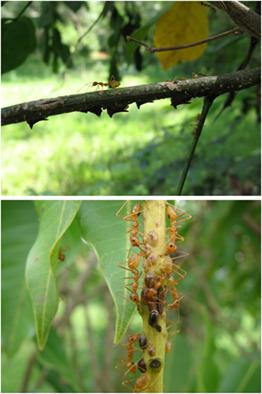当前位置:
X-MOL 学术
›
Agric. For. Entomol.
›
论文详情
Our official English website, www.x-mol.net, welcomes your
feedback! (Note: you will need to create a separate account there.)
Host plants and associated trophobionts of the weaver ant Oecophylla longinoda Latreille (Hymenoptera Formicidae) in Benin
Agricultural and Forest Entomology ( IF 1.6 ) Pub Date : 2021-12-30 , DOI: 10.1111/afe.12478 Jean‐François Vayssières 1, 2 , Isabelle Grechi 2, 3 , Antonio Sinzogan 4 , Issa Ouagoussounon 4 , Raymond Todjihoundé 4 , Soumanou Modjibou 4 , Jean‐Claude Tossou 4 , Appolinaire Adandonon 5 , Cinthia Kikissagbé 6 , Manuele Tamò 7 , Georg Goergen 7 , Anaïs Chailleux 2, 8 , Jean‐François Germain , Aristide Adomou 4
中文翻译:

贝宁织布蚁 Oecophylla longinoda Latreille (Hymenoptera Formicidae) 的寄主植物和相关滋养生物
更新日期:2021-12-30
Agricultural and Forest Entomology ( IF 1.6 ) Pub Date : 2021-12-30 , DOI: 10.1111/afe.12478 Jean‐François Vayssières 1, 2 , Isabelle Grechi 2, 3 , Antonio Sinzogan 4 , Issa Ouagoussounon 4 , Raymond Todjihoundé 4 , Soumanou Modjibou 4 , Jean‐Claude Tossou 4 , Appolinaire Adandonon 5 , Cinthia Kikissagbé 6 , Manuele Tamò 7 , Georg Goergen 7 , Anaïs Chailleux 2, 8 , Jean‐François Germain , Aristide Adomou 4
Affiliation

|
- The African weaver ant Oecophylla longinoda builds woven leaf nests inside tree canopies and is a major conservation biocontrol agent in sub-Saharan Africa. Weaver ant colonies provide well-protected and resource-rich environments for many associated trophobionts, thereby boosting their establishment on host plants.
- There is very little published literature on O. longinoda, their hosts plants and their associated trophobionts in West Africa. These tri-trophic interactions were studied over a period of four consecutive years (2010–2013) from south to north Benin.
- Our fieldwork revealed that all O. longinoda colonies were consistently associated with trophobionts. Oecophylla longinoda nests were recorded on 82 plant species belonging to 30 families, with 35 associated trophobiont species representing 11 families.
- Among cultivated plants, Mangifera indica was the most common species hosting O. longinoda, while Sarcocephalus latifolius the most frequent native one. Among trophobionts, Parasaissetia nigra, Udinia catori, Udinia farquharsoni (Coccidae) and Stictococcus sjostedti (Stictococcidae) were the most common hemipterans associated with O. longinoda.
- We identified a wide range of host plants that could be preserved (or planted) to promote the establishment of weaver ants to control different insect pests in fruit plantations in sub-Saharan Africa. When planted around fruit plantations with their nests and tended hemipterans, these host plants could facilitate biocontrol of mango fruit flies (Tephritidae) and cashew bugs (Coreidae, Miridae), by O. longinoda in the fruit plantations.
中文翻译:

贝宁织布蚁 Oecophylla longinoda Latreille (Hymenoptera Formicidae) 的寄主植物和相关滋养生物
- 非洲织布蚁Oecophylla longinoda在树冠内建造编织叶巢,是撒哈拉以南非洲的主要保护生物防治剂。韦弗蚁群为许多相关的滋养生物提供了良好保护和资源丰富的环境,从而促进了它们在寄主植物上的建立。
- 在西非,很少有关于O. longinoda、它们的寄主植物及其相关滋养菌的已发表文献。从贝宁南部到北部,连续四年(2010-2013 年)研究了这些三营养相互作用。
- 我们的田野调查显示,所有O. longinoda菌落始终与滋养菌有关。Oecophylla longinoda巢穴记录在 30 科 82 种植物中,其中 35 种相关滋养生物属 11 科。
- 在栽培植物中,Mangifera indica是最常见的寄生O. longinoda的物种,而Sarcocephalus latifolius是最常见的原生物种。在滋养生物中,黑副藻、乌迪尼亚卡托里乌迪尼亚、法夸尔松乌迪尼亚(球菌科)和斯氏链球菌(Stictococcidae)是最常见的与长尾吸虫相关的半翅目动物。
- 我们确定了可以保存(或种植)的多种寄主植物,以促进编织蚂蚁的建立,以控制撒哈拉以南非洲水果种植园中的不同害虫。当种植在带有巢穴和半翅目昆虫的水果种植园周围时,这些寄主植物可以促进水果种植园中O. longinoda对芒果果蝇(Tephritidae)和腰果虫(Coreidae,Miridae)的生物防治。











































 京公网安备 11010802027423号
京公网安备 11010802027423号